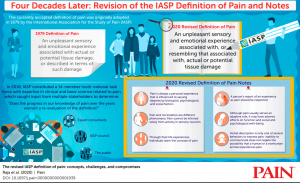Definition of Pain Updated for the First Time Since 1979
After 40 years, a multi-national, multidisciplinary Task Force of the International Association for the Study of Pain (IASP) developed a revised definition of pain that was published today in the journal, PAIN, along with the associated commentary by President Lars Arendt-Nielsen and Immediate Past President, Judith Turner. The revised definition included input from all potential stakeholders, including persons in pain and their caregivers.
The IASP Task Force crafted the revised definition, along with the six notes, to better convey the nuances and the complexity of pain in hope that it leads to improved assessment and management of those with pain.

The 2020 revised definition of pain is:
“An unpleasant sensory and emotional experience associated with, or resembling that associated with, actual or potential tissue damage,” and is expanded upon by the addition of six key notes and the etymology of the word pain for further valuable context:
- Pain is always a personal experience that is influenced to varying degrees by biological, psychological, and social factors.
- Pain and nociception are different phenomena. Pain cannot be inferred solely from activity in sensory neurons.
- Through their life experiences, individuals learn the concept of pain.
- A person’s report of an experience as pain should be respected.
- Although pain usually serves an adaptive role, it may have adverse effects on function and social and psychological well-being.
A central change in the new definition, compared to the 1979 version, is replacing terminology that relied upon a person’s ability to describe the experience to qualify as pain. The old definition read: “An unpleasant sensory and emotional experience associated with actual or potential tissue damage, or described in terms of such damage.”
This wording was interpreted as excluding infants, elderly people, and others – even animals — who could not verbally articulate their pain, said Dr. Jeffrey Mogil, Director of the Alan Edwards Center for Research on Pain, McGill University and member of the Task Force.





While this is a wonderful advance for both study of pain and palliative care, how sad that you included biological, psychological and social, and you never mentioned the fourth, essential, component of palliative care, the spiritual. Too often spiritual pain is NOT assessed and NOT addressed in palliative care. Spiritual distress is that “impaired ability to experience and integrate meaning and purpose in life through connectedness with self, others, art, music, literature, nature, and/or a power greater than oneself.” (Puchalski, 2012). If you do not assess and treat spiritual pain and spiritual distress, then you are not doing palliative care. You are doing physical pain management
Absolutely true
I accept
El dolor es muy complejo porque abarca varios aspectos del paciente y esto conlleva a un tratamiento minucioso por parte del galeno